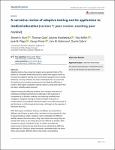A narrative review of adaptive testing and its application to medical education.
| dc.contributor.author | Burr, S | |
| dc.contributor.author | Gale, T | |
| dc.contributor.author | Kisielewska, J | |
| dc.contributor.author | Millin, P | |
| dc.contributor.author | Pêgo, JM | |
| dc.contributor.author | Pinter, G | |
| dc.contributor.author | Robinson, I | |
| dc.contributor.author | Zahra, D | |
| dc.date.accessioned | 2023-10-24T12:05:59Z | |
| dc.date.available | 2023-10-24T12:05:59Z | |
| dc.date.issued | 2023-10-24 | |
| dc.identifier.issn | 2312-7996 | |
| dc.identifier.issn | 2312-7996 | |
| dc.identifier.uri | https://pearl.plymouth.ac.uk/handle/10026.1/21483 | |
| dc.description.abstract |
Adaptive testing has a long but largely unrecognized history. The advent of computer-based testing has created new opportunities to incorporate adaptive testing into conventional programmes of study. Relatively recently software has been developed that can automate the delivery of summative assessments that adapt by difficulty or content. Both types of adaptive testing require a large item bank that has been suitably quality assured. Adaptive testing by difficulty enables more reliable evaluation of individual candidate performance, although at the expense of transparency in decision making, and requiring unidirectional navigation. Adaptive testing by content enables reduction in compensation and targeted individual support to enable assurance of performance in all the required outcomes, although at the expense of discovery learning. With both types of adaptive testing, candidates are presented a different set of items to each other, and there is the potential for that to be perceived as unfair. However, when candidates of different abilities receive the same items, they may receive too many they can answer with ease, or too many that are too difficult to answer. Both situations may be considered unfair as neither provides the opportunity to demonstrate what they know. Adapting by difficulty addresses this. Similarly, when everyone is presented with the same items, but answer different items incorrectly, not providing individualized support and opportunity to demonstrate performance in all the required outcomes by revisiting content previously answered incorrectly could also be considered unfair; a point addressed when adapting by content. We review the educational rationale behind the evolution of adaptive testing and consider its inherent strengths and limitations. We explore the continuous pursuit of improvement of examination methodology and how software can facilitate personalized assessment. We highlight how this can serve as a catalyst for learning and refinement of curricula; fostering engagement of learner and educator alike. | |
| dc.format.extent | 1-8 | |
| dc.format.medium | Electronic-eCollection | |
| dc.language | en | |
| dc.publisher | Taylor and Francis | |
| dc.subject | Assessment | |
| dc.subject | adaptive testing | |
| dc.subject | compensation | |
| dc.subject | different questions | |
| dc.subject | fairness | |
| dc.subject | personalised | |
| dc.subject | progress testing | |
| dc.subject | reliability | |
| dc.title | A narrative review of adaptive testing and its application to medical education. | |
| dc.type | journal-article | |
| dc.type | Journal Article | |
| dc.type | Review | |
| plymouth.author-url | https://www.ncbi.nlm.nih.gov/pubmed/38028657 | |
| plymouth.volume | 13(221) | |
| plymouth.publication-status | Published online | |
| plymouth.journal | MedEdPublish | |
| dc.identifier.doi | 10.12688/mep.19844.1 | |
| plymouth.organisational-group | |Plymouth | |
| plymouth.organisational-group | |Plymouth|Faculty of Health | |
| plymouth.organisational-group | |Plymouth|Users by role | |
| plymouth.organisational-group | |Plymouth|Users by role|Academics | |
| plymouth.organisational-group | |Plymouth|Faculty of Health|Peninsula Medical School | |
| dc.publisher.place | Scotland | |
| dcterms.dateAccepted | 2023-10-24 | |
| dc.date.updated | 2023-10-24T12:05:58Z | |
| dc.rights.embargodate | 2023-10-27 | |
| dc.identifier.eissn | 2312-7996 | |
| rioxxterms.versionofrecord | 10.12688/mep.19844.1 |


